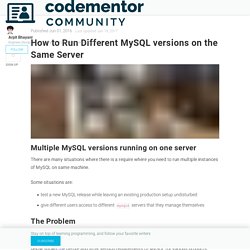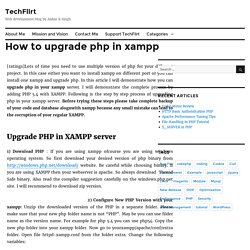

How to Run Different MySQL versions on the Same Server. Published Jun 01, 2016Last updated Jan 18, 2017 Multiple MySQL versions running on one server There are many situations where there is a require where you need to run multiple instances of MySQL on same machine.

Some situations are: test a new MySQL release while leaving an existing production setup undisturbedgive different users access to different mysqld servers that they manage themselves The Problem I have a machine with 5 products already setup. Since all but one products require MySQL 5.6, let's install it first and then we will work to figure out a way to install MySQL 5.5 as well.
Installing MySQL 5.6 sudo apt-get update sudo apt-get install mysql-server-5.6 mysql-server-core-5.6 mysql-client-5.6 mysql-client-core-5.6 At this point, we have MySQL 5.6 listening at port 3306 (default port) Approach to solution There are several approaches with which you can achieve multiple MySQL versions running on the same machine.
Use binaries of specific versionBuild everything from MySQL source. [ubuntu] [SOLVED] how to dump mysql database. Advanced Search Having an Issue With Posting ?
![[ubuntu] [SOLVED] how to dump mysql database](http://cdn.pearltrees.com/s/pic/th/ubuntu-solved-mysql-database-138011442)
Do you want to help us debug the posting issues ? < is the place to report it, thanks ! Results 1 to 6 of 6 Thread: [SOLVED] how to dump mysql database Quick Navigation New to Ubuntu Top « Previous Thread | Next Thread » Bookmarks Posting Permissions You may not post new threads You may not post replies You may not post attachments You may not edit your posts BB code is On Smilies are On [IMG] code is On [VIDEO] code is Off HTML code is Off Ubuntu Forums Code of Conduct. Apache - Error message "Forbidden You don't have permission to access / on this server" How to upgrade php in xampp or add new PHP verison - Techflirt. [ratings]Lots of time you need to use multiple version of php for your different project.

In this case either you want to install xampp on different port or you can install one xampp and upgrade php. In this article I will demonstrate how you can upgrade php in your xampp server. I will demonstrate the complete process by adding PHP 5.4 with XAMPP. Following is the step by step process of upgrading php in your xampp server. Before trying these steps please take complete backup of your code and database alognwith xampp because any small mistake can lead to the corruption of your regular XAMPP. Upgrade PHP in XAMPP server 1) Download PHP : If you are using xampp ofcourse you are using windows operating system. 2) Configure New PHP Version with your xampp: Unzip the downloaded version of the PHP in a separate folder.
Variable PHPINIDir to be <your xampp folder>/<new version of PHP>Varaible LoadModule to be <your xampp folder>/<new version of PHP>/php5apache2_2.dll Author: Ankur Kumar Singh. Use XAMPP PHP CLI in your command line - Blog of Shaharia Azam. Published on October 1st, 2013 in PHP To use XAMPP’s PHP as default PHP in your command line to execute PHP commands from your command line/prompt you have to just follow the simple steps mentioned below: in this tutorial I used UBUNTU as my OS Open your terminal and open .bashrc file by following command: If you don’t use GUI or gedit not installed then you can use vim instead of gedit like following and just you have to add the following line at the end of your .bashrc file. export PATH=/opt/lampp/bin:$PATH Now restart your terminal and you are done!

© All rights reserved by Shaharia Azam Powered by Wordpress | Theme developed by @shaharia with. Apache - Adding VirtualHost fails: Access Forbidden Error 403 (XAMPP) (Windows 7) Creating new virtual host while using Xampp in Ubuntu (Linux) - DevArticles.In. I need this stuff quite often.

Every time i need to create a new virtual host in Ubuntu i have to google/search to find this solution as i cannot remember these paths properly. I am posting it here for quick reference for myself. Bookmark it for yourself (which i am going to do after i have finished posting it ;)) 1. Enable virtual hosts by editing httpd.conf, if it is not enabled already. Sudo gedit /opt/lampp/etc/httpd.conf Find #Include etc/extra/httpd-vhosts.conf and remove the # to un-comment this line Include etc/extra/httpd-vhosts.conf 2. Sudo gedit /opt/lampp/etc/extra/httpd-vhosts.conf Usually, by default there are two virtual hosts in this file. <VirtualHost *:80> ServerAdmin your_email@domain_name.com DocumentRoot /opt/lampp/htdocs/mysite_folder ServerName mysite.local ServerAlias www.mysite.local ErrorLog logs/mysite.local-error_log CustomLog logs/mysite.local-access_log common </VirtualHost>